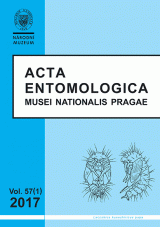Micromorphology of egg and larva of Eristalis fratercula, with an updated key of Eristalis species with known third instar larvae (Diptera: Syrphidae)
Campoy Andrés, Pérez-Bañon Celeste, Nielsen Tore R., Rojo Santos
Acta Entomologica Musei Nationalis Pragae 57(1): 215-227, 2017
Published online: 30th June 2017
Views: 1511
Abstract: The flower- or hoverflies (Syrphidae) and particularly the subfamily
Eristalinae, are known by their importance as pollinators in both natural and
agro-ecosystems. Similar to other saprophagous eristalines, the larvae of
Eristalis Latreille, 1804 are characterized by an elongated anal segment and a
telescopic breathing tube. These features have given them the common name of
rat-tailed maggots and allow them to develop in liquid or semi-liquid media
loaded with decaying organic material. This paper presents the first description
of the egg and the third-instar larva of the boreal species Eristalis fratercula
(Zetterstedt, 1838). Morphological studies are presented based on cryo-scanning
electron microscopy (cryo-SEM). After comparison with all other known species of
the genus Eristalis with described preimaginal morphology, we conclude that main
diagnostic character of E. fratercula is the presence of long branched spicules
located in the upper margin on the lateral lips. Finally, we provide an updated
key that includes the 15 Eristalis species whose third larval stages have
already been described.
Key words: Diptera, Syrphidae, Eristalis, hoverflies, preimaginal morphology, egg, larva, cryo-SEM, Norway, Palaearctic Region
Papers
Astatometopon sakakibarai gen. & sp. nov., a montane planthopper from Chile Hemiptera: Fulgoroidea: Delphacidae)First record of the genus Raunolina (Hemiptera: Fulgoroidea: Caliscelidae) from tropical Africa with description of two new species from Sudan and Saudi ArabiaA new species of Isometopus from Iran (Hemiptera: Heteroptera: Miridae: Isometopinae)A new genus and three new species of apterous Carventinae from China (Hemiptera: Heteroptera: Aradidae)Latidrymus, a new genus of Drymini from the Oriental Region (Hemiptera: Heteroptera: Rhyparochromidae)The genus Anasa from Ecuador with description of three new species and key to the Ecuadorian species (Hemiptera: Heteroptera: Coreidae)A revision of Sagriva (Hemiptera: Heteroptera: Dinidoridae)Description of immature stages of Laccobius kunashiricus, with a key to genera of the Laccobiini based on larval characters (Coleoptera: Hydrophilidae)A new genus and two new species of Leiodinae from Chile, with keys to world genera of Sogdini and Leiodinae from Chile and Argentina (Coleoptera: Leiodidae)A new species of the genus Cerylambus from southern China (Coleoptera: Staphylinidae: Pselaphinae)A new species-group of the genus Anthaxia (Haplanthaxia) from south-eastern Asia, with descriptions of two new species (Coleoptera: Buprestidae: Anthaxiini)A new species of Synchonnus (Coleoptera: Lycidae) from New Guinea, with an identification key to the Papuan speciesThree new Asian species of Bruchidius (Coleoptera: Chrysomelidae: Bruchinae)Two new species of the Gonioctena mauroi species-group from China (Coleoptera: Chrysomelidae: Chrysomelinae)Description of a new species and revised key to species of the Enicospilus antefurcalis species-group from Japan (Hymenoptera: Ichneumonidae: Ophioninae)Leptomorphus sevciki sp. nov., a remarkable new wasp-mimicking fungus gnat from Brunei (Diptera: Mycetophilidae)A new Palaearctic Thornburghiella from Transcaucasia (Diptera: Psychodidae)Micromorphology of egg and larva of Eristalis fratercula, with an updated key of Eristalis species with known third instar larvae (Diptera: Syrphidae)Periscelis fugax sp. nov., an overlooked European species of Periscelididae (Diptera), with notes on the morphology and terminology of terminaliaIs the genus Potamophylax (Trichoptera: Limnephilidae) highly polymorphic?Tinea altaica sp. nov. and new records of some small moths from the Russian Altai (Lepidoptera: Meessiidae, Tineidae, Douglasiidae, Epermeniidae, Glyphipterigidae: Acrolepiinae)Neolycaena (Rhymnaria) arcana sp. nov. from Tibet (Lepidoptera: Lycaenidae)Catalogue of type specimens of beetles (Coleoptera) deposited in the National Museum, Prague, Czech Republic. Scarabaeoidea: Lucanidae and PassalidaeCatalogue of type specimens of ants (Hymenoptera: Formicidae) deposited in Czech museums 